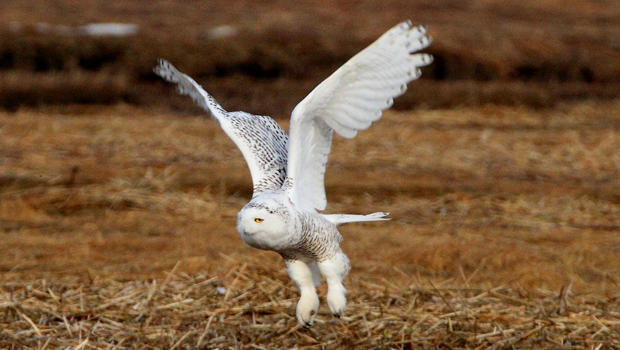Nature up close: Snowy owls down south
By "Sunday Morning" contributing videographer Judy Lehmberg.
The excitement within the Fort Worth, Texas, birding community was tangible several weeks ago: For the first time in the memory of local birders, a snowy owl showed up in Forth Worth! Binoculars rose up to birders' eyes like saluting soldiers on parade as the sighting rippled through the birding community. This birding event even made the nightly news.
The only sound was the clicking of camera shutters and the quiet elation of the observers. The owl was a member of the birding world's royalty, and the birders knew it. Unfortunately, the owl only hung around for a day or so.
I grew up in Fort Worth and now live about 300 miles south of there. I didn't get there fast enough so I still can't add a snowy owl to my list, but a number of happy Texas birders now can, including Randall Patterson, who provided some of the photos for this story. (Click here for the CBS Station KTVT video featuring the snowy owl and Patterson.)
Snowy owl migration is not completely understood. They nest on the Arctic tundra in the summer and some migrate south in the winter. For no known reason some snowy owls actually move further north in the winter, out to the Arctic Sea ice, where they must hunt in mostly total darkness. Occasionally they move further south during what are termed irruptions. Minor irruptions occur every few years, but infrequently a major irruption occurs. Then, the owls move even further south in even greater numbers, into northern Florida and, at least once, to northern Texas.
This year's irruption was forecast more than six months ago. For years it was believed the owls moved south in search of food, but newer research indicates it may be just the opposite. The more food on the tundra, the more babies survive to maturity, and therefore more move south in the winter. One nest, photographed in the summer of 2013, had 70 lemmings and eight voles surrounding it -- food carried in to the young far in excess of the owl chick's needs. Similar studies during the summer of 2017 produced similar results.
The irruptions only last one year as immature owls are much more likely to die by hitting power lines, colliding with vehicles, and from the rodent poisons that bioaccumulate in these predators.
Snowy owls are mysterious creatures to both scientists and birders. Sighting a snowy owl in Fort Worth is akin to spotting a polar bear strolling down Main Street.
Ebird is the largest citizen science project on earth and is a great resource for learning more about snowy owl irruptions. To view a map, go to ebird.org.
Judy Lehmberg is a former college biology teacher who now shoots nature videos.
For more info:
- Judy Lehmberg (Official site)
- Judy Lehmberg's YouTube Channel
To watch extended "Sunday Morning" Nature videos click here!






